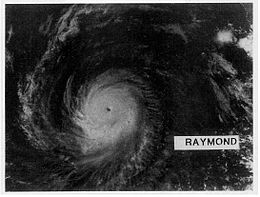Hurricane Raymond (1989)
| Category 4 major hurricane (SSHWS/NWS) | |

Hurricane Raymond near peak intensity on September 30
|
|
| Formed | September 25, 1989 |
|---|---|
| Dissipated | October 5, 1989 |
| Highest winds |
1-minute sustained: 145 mph (230 km/h) |
| Lowest pressure | 935 mbar (hPa); 27.61 inHg |
| Fatalities | 1 direct |
| Damage | $1.75 million (1989 USD) |
| Areas affected | Baja California Peninsula, northeastern Mexico, Arizona, Texas, Oklahoma, Kansas, and Missouri |
| Part of the 1989 Pacific hurricane season | |
Hurricane Raymond was the strongest tropical cyclone of the 1989 Pacific hurricane season, peaking as a strong Category 4 hurricane on the Saffir-Simpson Hurricane Scale. Forming out of a tropical wave on September 25, the tropical depression slowly tracked northwest before becoming nearly stationary the next day. Shortly after, the depression intensified into Tropical Storm Raymond and took a general westward track. Gradually intensifying, Raymond attained hurricane-status on September 28 and attained its peak intensity on October 31, with winds of 145 mph (233 km/h) and a barometric pressure of 935 mbar (hPa; 27.61 inHg). Steady weakening then took place and by October 3, Raymond turned northeast towards land. The storm continued to weaken as it accelerated and eventually made landfall on the Baja California Peninsula as a tropical storm late on October 4 and a second landfall in Sonora, Mexico. Shortly after, Raymond weakened to a depression as it tracked inland. The remnants of the system persisted until October 7 when it dissipated over the Central United States.
Due to the rapid motion of the storm, little impact was felt in Mexico. Moderate rain fell in association with Raymond, peaking at 4.72 in (120 mm) in Nogales. There, flooding destroyed a bridge and nearby store, leaving $250,000 in damage. The remnants of Raymond produced more significant damage in the United States. Tucson, Arizona recorded 4.5 in (110 mm) of rain from the storm, resulting in flash flooding that reached a depth of 2 ft (0.61 m) in some places. In nearby Willcox, flood waters inundated roughly 75% of the city. High winds from the storm also resulted in one fatality after a mobile home was destroyed. In all, damage throughout Arizona amounted to $1.5 million.
Hurricane Raymond originated out of a tropical wave that also spawned Hurricane Hugo in early-September. With little convective development, the wave tracked westward across the Atlantic Ocean, entering the Caribbean Sea several days later. By September 22, shower and thunderstorm activity increased as it crossed Central America and entered the eastern Pacific basin. By September 24, the wave had become sufficiently organized for the Dvorak Technique to be implemented on the system. The National Hurricane Center (NHC) estimated that the wave spawned Tropical Depression Twenty One-E about 200 miles (320 km) south of Acapulco, Mexico. Operationally, the NHC did not begin issuing advisories on the depression until September 26; at that time, the system's outflow developed and the depression was nearly stationary as a mid-level low over Mexico moved south. Shortly after, the depression was upgraded to a tropical storm and given the name Raymond by the NHC.
...
Wikipedia
